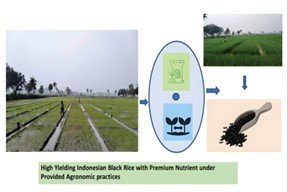Determination of fertilizer requirement of Indonesian black rice in winter season under different plant spacing at Agro-ecological Zone-9 of Bangladesh
https://doi.org/10.26832/24566632.2024.0903021
Abstract
Indonesian black rice is quite popular for its highly nutritive value and profitable production. The distinct knowledge about optimum fertilizer doses and plant spacing contributes to its promising yield. The experiment was conducted at the Agronomy Field Laboratory, Bangladesh Agricultural University, Mymensingh, from December 2022 to May 2023 to find out the effect of fertilizer management and plant spacing on the growth and yield of Indonesian black rice in the winter season. The experiment was conducted with 5 treatments of fertilizer management viz., F1(70% of recommended doses); F2(80% of recommended doses); F3(90% of recommended doses); F4(100% of recommended doses) and F5(110% of recommended doses) with 4 plants spacing viz., S1(20 cm × 15 cm); S2(20 cm × 20 cm); S3(25 cm × 15 cm) and S4(25 cm × 20 cm). The experiment was laid out in a split-plot design where the fertilizer management was allocated in main plots and the plant spacing was distributed in sub-plots with three replications. The result revealed that the fertilizer doses and plant spacings along with the interaction effects significantly influenced the growth and yield parameters of Indonesian black rice. Regarding vegetative growth, plant height (79.3cm), total tiller plant-1(21.27cm), and total leaf number plant-1 (58.47) were maximal at 100% recommended dose of fertilizer(F4) at DAT 65. Similarly, S2(20 cm × 20 cm) had better result in crop growth and yield attributes. The interaction effects of the treatments showed significant impact on plant height, total tiller and leaf number where F4S2 gave satisfied results. The highest values for the yield parameters including the maximum number of grains panicle-1 (100.70), 1000-grain weight (28.33g), and grain yield (5.69g) were found from the combination treatment of F4S2. On the other hand, the lowest grain (3.68g) yield was found from F1S4. Therefore, observing the results of the experiment, the best consideration was F4S2 at Agro-ecological Zone-9 in the winter season for the desirable growth and yield of Indonesian black rice.
Keywords:
Black rice, Fertilizer management, Nutrient management, Plant spacingDownloads
References
Aparna, V., Pvn, P., Babu, R., Assisstant, M., & Mrudhula, A. (2022). Effect of planting geometry and nitrogen levels on growth parameters, yield attributes, and yield of black rice. The Pharma Innovation Journal, 11(9), 2260–2264.
Das, S. (2017). Rice Cultivation under Changing Climate with Mitigation Practices: A Mini Review. Universal Journal of Agricultural Research, 5, 333–337. https://doi.org/10.13189/ujar.2017.050603
Erythrina, E., Pratiwi, G. R., Agustiani, N., & Nurrahma, A. H. I. (2023). Nitrogen Fertilizers and Plant Spacing in Organic Rice Cultivation: A Review. Journal of Applied Agricultural Science and Technology, 7(3), Article 3. https://doi.org/10.55043/jaast.v7i3.143
FAO, U. (1988). Land Resources Appraisal of Bangladesh for Agricultural Development Report No. 2. Agro-ecological Regions of Bangladesh. United Nations Development Programme and Food and Agricultural Organization., Rome., Italy, 212-221.
Fitri, I. G. S., Nurhasanah, & Handoyo, T. (2021). Genetic and phytochemical analysis of Indonesian black rice cultivars. Journal of Crop Science and Biotechnology, 24(5), 567-578.
Ito, V. C., & Lacerda, L. G. (2019). Black rice (Oryza sativa L.): A review of its historical aspects, chemical composition, nutritional and functional properties, and applications and processing technologies. Food Chemistry, 301, 125304.
Pradipta, S., Ubaidillah, M., & Siswoyo, T. A. (2020). Physicochemical, Functional and Antioxidant Properties of Pigmented Rice. Current Research in Nutrition and Food Science Journal, 8(3), 837–851.
Rahman, M.R., Rahmana, M.R., Fazala, M.J., & Anwarb, M.P. (2020). Phenological Characterization and Yield Performance of Hilly Black Rice Cultivars Under Year-Round Cultivation in Plain Land Ecosystem of Bangladesh. Tropical Agrobiodiversity (TRAB), 1(2), 66-71.
Rao, T.V., Dua, S., & Saha, P. (2022). Identifying Black Rice Cultivated Area Using Sentinel2. Journal of Scientific Research, 66(2), 214–219.
Saha, K. K., Paul, S. K., & Sarkar, Md. A. R. (2020). Influence of spacing of planting on the yieldperformance of some aromatic rice varieties in Boro season. Suatainability in Food and Agriculture, 1(1), 10–14. https://doi.org/10.26480/sfna.01.2020.10.14
Sutrisno, Susanto, F. A., Wijayanti, P., Retnoningrum, M. D., Nuringtyas, T. R., Joko, T., & Purwestri, Y. A. (2018). Screening of resistant Indonesian black rice cultivars against bacterial leaf blight. Euphytica, 214(11), 199.
Thapa, S., Thapa, K., Shrestha, J., & Chaudhary, A. (2019). Effect of seedling age, seeding density and nitrogen fertilizer on growth and grain yield of rice (Oryza sativa L.). International Journal of Applied Biology, 3(1), 81–87.
https://doi.org/10.20956/ijab.v3i1.6688
Wu, Q., Wang, Y., Ding, Y., Tao, W., Gao, S., Li, Q., Li, W., Liu, Z., & Li, G. (2021). Effects of different types of slow- and controlled-release fertilizers on rice yield. Journal of Integrative Agriculture, 20(6), 1503–1514. https://doi.org/10.1016/S2095-3119(20)63406-2
Yuniarti, A., Joy, B., Sara, D. S., Fazrin, & Intan. (2024). The Effect of N, P, K and Si Fertilizers on Some Soil Chemical Properties, N, P uptake and Growth of Black Rice (Oryza sativa L. indica) in Ultisols. International Journal of Life Science and Agriculture Research, 3(2), Article 2. https://doi.org/10.55677/ijlsar/V03I2Y2024-02

Published
How to Cite
Issue
Section
Copyright (c) 2024 Agriculture and Environmental Science Academy

This work is licensed under a Creative Commons Attribution-NonCommercial 4.0 International License.

